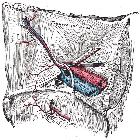indirect inguinal hernia
Indirect inguinal hernias (alternative plural: herniae), a type of groin herniation, are the most common type of abdominal hernia.
Epidemiology
It is five times more common than a direct inguinal hernia, and is seven times more frequent in males, due to the persistence of the processus vaginalis during testicular descent.
In children, the vast majority of inguinal hernias are indirect.
Pathology
Indirect inguinal hernias arise lateral and superior to the course of the inferior epigastric vessels, lateral to the Hesselbach triangle, and then protrude through the deep or internal inguinal ring into the inguinal canal. An indirect hernia enters the inguinal canal at the deep ring, lateral to the inferior epigastric vessels. It passes inferomedially to emerge via the superficial ring and, if large enough, extend into the scrotum.
Gender differences
- males: they enter the canal anterior to the spermatic cord and may extend through the external inguinal ring into the scrotum
- females: they tend to follow the round ligament into the labia majora
Contents
Contents may include mesenteric fat (most common), peritoneal fluid, small bowel loops, mobile colon segments (sigmoid, cecum, appendix).
Many are longstanding and asymptomatic, although the sheer size can become burdensome.
Treatment and prognosis
Complications include:
- incarceration
- the most common complication associated with inguinal hernias, the incidence could be as high as 30% for infants younger than 2 months
- strangulation with bowel ischemia and perforation
- intestinal obstruction
Differential diagnosis
On imaging, consider:
- direct inguinal hernia
- emerges medially to the inferior epigastric vessels and above the inguinal ligament
- the inguinal canal is usually compressed/displaced ("lateral crescent sign")
- femoral hernia
- exit below the inguinal ligament and caudal to the emergence of the inferior epigastric vessels
On testicular ultrasound, one could consider spermatic cord lipoma on the differential if an inguinal hernia contains only omental fat. Movement of the fat with the Valsalva maneuver is more likely an indirect hernia.
Siehe auch:
und weiter:

 Assoziationen und Differentialdiagnosen zu indirekte Leistenhernie:
Assoziationen und Differentialdiagnosen zu indirekte Leistenhernie:

